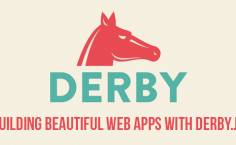Before Node.js, web developers always faced the issue of having to use different languages for client-side and server-side scripts. JavaScript was traditionally the language for client-side scripting with the HTML code running in the browser. The invention of Node.js in 2009 introduced server-side scripting with JavaScript code running on the server and generating full dynamic web pages before returning them to the browser. This was a major breakthrough in web development, as Node.js allows using JavaScript both client-side and server-side.
Developers have created quite a number of frameworks for Node.js development to facilitate web application development.
With the global popularity of JavaScript, the list of Node.js frameworks is quite long - that’s why we list only those which we consider most performing.
Hapi.js

Hapi.js is a rich framework for building applications and services that enable developers to focus on writing reusable application logic instead of spending time building infrastructure. It's a powerful plugin system with outstanding features such as input data validation, configuration-based functionality, caching, error handling, logging, etc. Hapi.js is used to build useful applications and provide technology solutions for many large-scale websites such as Walmart, Disney, PayPal, and Concrete.
$ npm install hapi
Node.js framework for building application programming interfaces (APIs) and other software applications.
Express.js

Express is a minimal and flexible Node.js web application framework that provides a robust set of features for web and mobile applications built by TJ Holowaychuk, a member of the Node team that created Node.js. Express provides a thin layer of fundamental web application features, without obscuring Node.js features that you know and love. Many popular frameworks are based on Express, such us:
- Feathers: Build prototypes in minutes and production ready real-time apps in days.
- ItemsAPI: Search backend for web and mobile applications built on Express and Elasticsearch.
- KeystoneJS: Website and API Application Framework / CMS with an auto-generated React.js Admin UI.
- Kraken: Secure and scalable layer that extends Express by providing structure and convention.
- LoopBack: Highly-extensible, open-source Node.js framework for quickly creating dynamic end-to-end REST APIs.
- MEAN: Opinionated full-stack JavaScript framework that simplifies and accelerates web application development.
- Sails: MVC framework for Node.js for building practical, production-ready apps.
- Hydra-Express: Hydra-Express is a light-weight library which facilitates building Node.js Microservices using ExpressJS.
- Blueprint: a SOLID framework for building APIs and backend services
- Locomotive: Powerful MVC web framework for Node.js from the maker of Passport.js
- graphql-yoga: Fully-featured, yet simple and lightweight GraphQL server
- Express Gateway: Fully-featured and extensible API Gateway using Express as foundation
Socket.io

Socket.IO enables real-time, bidirectional and event-based communication. It works on every platform, browser or device, focusing equally on reliability and speed.
Koa.js

Koa is a new web framework designed by the team behind Express, which aims to be a smaller, more expressive, and more robust foundation for web applications and APIs. By leveraging async functions, Koa allows you to ditch callbacks and greatly increase error-handling. Koa does not bundle any middleware within its core, and it provides an elegant suite of methods that make writing servers fast and enjoyable.
Meteor.js

Meteor is an open source platform for web, mobile, and desktop. The platform works well for OS X, Windows and Linux operating systems. It's a full-stack JavaScript platform for developing modern web and mobile applications. Meteor includes a key set of technologies for building connected-client reactive applications, a build tool, and a curated set of packages from the Node.js and general JavaScript community.
-
Meteor allows you to develop in one language, JavaScript, in all environments: application server, web browser, and mobile device.
-
Meteor uses data on the wire, meaning the server sends data, not HTML, and the client renders it.
-
Meteor embraces the ecosystem, bringing the best parts of the extremely active JavaScript community to you in a careful and considered way.
-
Meteor provides full stack reactivity, allowing your UI to seamlessly reflect the true state of the world with minimal development effort.
Derby

This is an MVC framework that supports creating real-time mobile applications and web applications. DerbyJS is a full-stack framework for writing modern web applications.
Templates can be rendered in the browser and on the server. In a browser, DerbyJS renders with fast, native DOM methods.
On the server, no DOM or virtual DOM implementation is needed—the same templates return HTML as well! HTML rendering means faster page loads, full search engine support, and the ability to use the same templates for all types of HTML output, such as emails.
Sails.js

Sails.js can be viewed as the most popular real-time framework that is based on MVC (Model View Controller) pattern. It was released in 2012 as free and open source software under the MIT license. It is a cross-platform web application framework written in JavaScript. It was mainly developed to create custom and business-oriented Node.js applications. Some important points about Sails.js are:
- Commonly used while implementing data-driven APIs in order to create real-time chatting applications, dashboards, and games.
- Works well with other front-end development platforms like Angular, Backbone, React, Android, iOS, Windows, Java and many others. Hence developers can choose the toolsets of their choice.
- Ability to support Grunt modules such as LESS, SASS, Stylus, CoffeeScript, Pug (formerly Jade), and Dust. Therefore it is considered ideal for creating browser-based applications.
- Incorporates waterline.js, which further provides support for an object-relational mapping interface and database solutions. This helps developers in avoiding trouble while configuring several database queries.
- Implements Express.js in order to manage HTTP requests.
- Extensively used in the development of websites. For instance, the website of Verizon, which is a US-based telecommunications company, is developed using this framework. Another implementation of this framework can be viewed on the website of Detroit Lions, an American football team.

